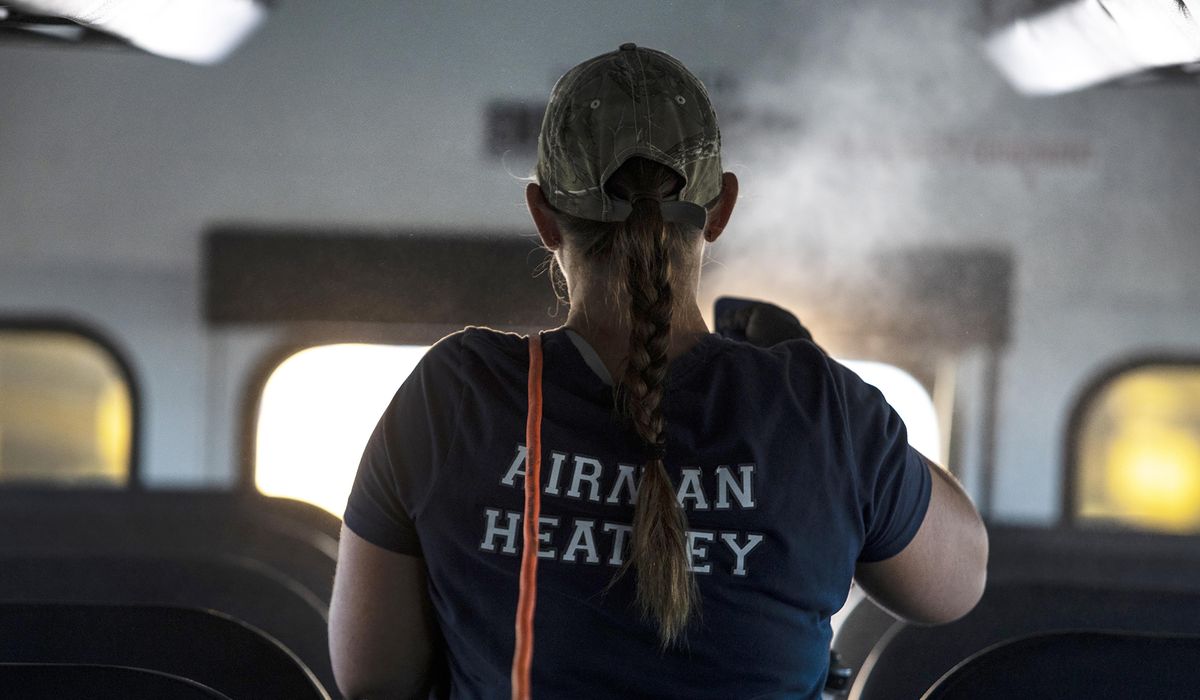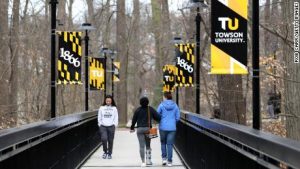GILLETTE, Wyo. (AP) – In a normal school year, managing the transportation efforts of the Campbell County School District is a logistical achievement most don’t think to appreciate but would boggle the mind if they did.
Keith Chrans, the district’s transportation supervisor, oversees a staff of 190 employees, 135 of which are drivers and substitutes. In normal times, he said the daily absence rate for drivers is around 20%. His department serves a district of about 9,000 students, nearly half of whom ride the bus. There is a fleet of 170 buses and 116 routes that cover an area of 5,000 square miles, traveling 10,500 miles a day. Over the course of a year, they will cover more than 2 million miles.
Those routes can’t be finalized until the district communicates with parents about whether their children need a ride which, depending on the parents, can sometimes take more than one effort to reach. In a normal year, the biggest challenge is the students who don’t live within the school’s attendance area and the needs of individuals, like separate pick-up and drop-off locations.
Then came COVID-19.
Picking up and dropping off the district’s schoolchildren will be fundamentally different than just-in-time delivery services for drivers and staff. The spring taught them a great deal about how to successfully manage the challenges of the pandemic, the Gillette News Record reported.
Chrans said the transportation department’s plan for the fall depends almost entirely on how many students end up needing a bus. The goal for all routes will be to maintain social distancing, but that will depend on the demand for services on a particular route.
Chrans said the department staffing is up this year – normally, it’s 10-15 drivers understaffed – but he’s hired extra that can be used as substitutes, nearing a total of 150 drivers.
The changes on buses will be physically noticeable as well, said Terri Gawronski, the shop manager for the district’s transportation department, who described the preparation measures taken ahead of the school year.
“Already we’ve installed hand sanitizer on all the buses,” Gawronski said. “We have masks on the buses. If necessary, we’re going to put up shields on the buses.”
Additional sanitizing measures are also going to be performed throughout the school year. The bus garage hired a new employee, Rachel Hetler, just to fog the fleet of buses with disinfectant.
The Hurricane ES is a portable electrostatic aerosol applicator, or fogger, that sprays out a fine mist of a combination of VitalOxide and water, which Gawronski said is mixed at a strong concentration. According to the product’s website, the disinfectant “kills 99.999% of bacteria and viruses, including H1N1, MRSA, Norovirus, HIV, Legionella, Pseudomonas aeruginosa, Hepatitis A, B, C and Ebola virus,” and has been approved by the Environmental Protection Agency for use against COVID-19. Gawronski said it disinfects a bus very quickly.
Those measures are in addition to the social distancing that Chrans is building into every route. Given the relatively cramped space, a bus typically has multiple kids per seat, but this year’s bus loads will look considerably different.
“Social distancing on a bus is every other seat, every other side, zigzagging all the way down,” Chrans said. In the likelihood that kids don’t stay seated near the window throughout the trip, Chrans said the space was an added precaution.
“If we need to, and we have buses available, then we could add some routes,” Chrans said. “And if we have to split up a route to maintain our distancing, then we’ll do that. It may not work in every case, but if we can, we’ll do that first.”
Communication with parents early and often is key, Chrans said. One issue that parents need to know as early as possible is the delayed reaction time for mid-year changes, Chrans said.
“We’ll communicate to parents that if you change your mind or want busing later, it can’t happen overnight,” he said. “Where before parents could call up and say, ‘I need busing, I need busing,’ and we’d start it the next day or even that afternoon. But that’s not going to happen. Now it might be a two- or three-day lag time between request and being able to provide that service to make sure we can maintain that safety that we’ve already set up on that route.”
One of the safety precautions of which Chrans spoke was, of course, face coverings. The wearing of face masks has become increasingly politicized, including in Campbell County as the decisions by retailers like Walmart and Menards to require masks in their stores have drawn harsh condemnation from some residents. Chrans said he knows the same objections are sure to come his way if social distancing can’t be maintained.
If social distance cannot be maintained, students on buses will be required to wear masks, assuming the governor’s public health orders were to be extended.
The governor’s order, currently in effect until Aug. 31, requires at least 6 feet of spacing between students as much as possible. When that can’t happen, face coverings will be required.
School districts in Indiana, Georgia, Tennessee, Mississippi and North Carolina are garnering national media attention because they have started their new school years with in-person instruction and have already reported positive tests for coronavirus within days of opening. Wyoming officials will be leery of adding Wyoming to that list.
With a mask requirement a looming reality, Chrans said informing parents is vital to a successful school year.
“Our communication to parents will be, ‘If the particular bus route that your student is on would require face coverings, would you still want busing?’” Chrans said. “That way we’re letting them know ahead of time.
“If parents are adamant that their child not wear a mask or face covering, then that’s going to be the biggest challenge,” he said. “How do we offer the best service we can and still take care of our community?”
Chrans likened the face mask issue to seat belts on buses.
“What’s funny is I’ve only had one phone call or conversation with a parent about, ‘Why should my child have to wear a seat belt on a bus?’” Chrans said. “Of course, No. 1, it’s the rule; No. 2, it’s the law; No. 3, it’s safer for your kid.’”
“‘Well, they’re not going to wear a seat belt; what are you going to do?’” Chrans said, paraphrasing a disgruntled parent. “Well, now, guess what? They can’t ride the bus.”
The same would be true for children and parents not willing to comply with face mask rules.
“Ultimately, it’s the loss of bus privileges,” Chrans said.
Lessons learned from spring leave district feeling prepared
This past spring introduced the country to words like COVID-19 and pandemic. Gov. Mark Gordon declared a state of emergency March 13 and two days later, on a Sunday, he recommended that schools be closed through April 3. The following day began CCSD’s spring break, which would last three weeks instead of the usual one.
It was during those extra two weeks that district officials scrambled to find a way forward. By March 27, the district had formulated a plan, which was simple in theory: Students would study from home beginning April 6.
After the district decided what the rest of the year would look like, Chrans was able to consider how the transportation department might contribute. Again, the solution seemed easy: The district would simply deliver whatever materials students needed, including electronic devices, since even if a family had devices at home, they might not be compatible with the school’s information system.
In practice though, the logistical challenge of getting materials and devices to all students in the third largest school district in Wyoming, where one in every 10 of Wyoming’s K-12 students attend, was quite difficult.
“When we had our first meeting about potentially doing off-site learning and how to get materials to kids and families, we did not know how much transportation would be utilized for that,” Chrans said. “When I was first asked about that, my answer was, ‘Oh yeah, we could probably get that done in a day.’ Well, we did not know how big a project that would be.”
It ended up being quite an undertaking.
“We think that in those first four days, we delivered over 30,000 pieces of materials,” Chrans said.
He described the effort as unique among school districts, that while many districts did food deliveries, which Campbell County did as well, not many took on the challenge of delivering devices and materials and continuing that service throughout the remainder of the semester. Health and safety for students and families topped the list of reasons why the district opted for such an ambitious effort.
Chrans also cited the assurance that students got what they needed.
“With it being such a mobile and busy community, what if people couldn’t come get it,” he said.
Once the decision was made to conduct deliveries, the next question became how to do it effectively.
“As far as our transportation team, the question was, ‘How do we even make a schedule?’” Chrans said.
The normal routes used to pick up kids couldn’t be used for this new task of dropping off materials because there would be too much inefficiency, too much backtracking and crisscrossing.
“We created what we called zones, and we basically took the whole county and split it into 37 zones,” Chrans said. “We took the zones, and we took the routes we already had and we married those together.”
Transportation worked closely with the schools and the district’s print shop, which turned a space into a mail delivery room with every zone identified.
The schools would send homework assignments to the print shop, and it would get separated into the appropriate zone and picked up by the bus driver covering that zone.
“For those first four days, we hit the print shop, we hit the schools, we hit the Lakeway Learning Center to pick up anything that would need to go to all these homes,” Chrans said. “Pretty much all the buses had to hit every location to get all this material and get it delivered.”
After that initial push to get materials out by the time remote learning started April 6, bus drivers came to work to find a delivery sheet that dictated their days.
“Now daily, every school would send us an email by 10 a.m. and tell us what zones they had for delivery,” Chrans said.
That would get turned into a spreadsheet for drivers.
Chrans said the drivers would come to work at 9 a.m. to pre-trip their buses and get ready for the day and were headed to the print shop shortly after 10. They would then go to their schools by 11 and would deliver until about 3 p.m.
Challenges faced the drivers at every turn. Chrans said there was a scramble to find enough drivers, some of whom couldn’t because they’d lost their access to child care. He said his team was reduced to about 70 employees, 50 drivers and 20 staff, down from the full team of 190. On the Thursday they began their deliveries, the drivers were greeted with a snowstorm that dropped about 4 inches of snow and sent temperatures plummeting, Chrans recalled.
The bus drivers were now as indispensable as U.S. Postal Service workers and UPS and FedEx delivery drivers.
“I look at a mail truck, it’s just one step and they’re off,” Chrans said. “But a bus is three or four steps, and they’re not really designed for mail delivery. Our staff did yeoman’s work, toting tubas and violins and laptops up to parents.”
Chrans estimated the number of materials delivered to be between 4,000 and 5,000 daily.
The drivers made all of those deliveries while maintaining social distancing from each other and families. They drove buses and another person riding along with them to assist in the deliveries sat at a distance.
“I drove the bus, and my partner was about five or six seats back for social distancing,” said Dale Boedeker, a full-time activities driver for the district who answered the call for drivers when the district needed them.
Gawronski described the strangeness of that experience from the shop’s perspective.
“We isolated ourselves,” she said. “We didn’t really get to see the drivers. They would come in and get their keys and go. They weren’t allowed to be in here. And we usually have drivers walking through the shop, talking to the mechanics. It was that separation. You don’t have that camaraderie anymore, you don’t have those people to talk to but you know they’re out there because you hear them talking on the radio.”
Just like U.S. Postal Service workers, Chrans said the bus drivers had to worry about dogs. Beyond the normal “slips, trips and falls,” one of the largest safety issues for the drivers was dog bites. There were six incidents in the spring.
But the biggest stumbling block for the district’s transportation efforts was not due to the weather or the number of students or the distance to be traveled. It was simply a matter of communication, or more accurately, a lack thereof. Student information often hadn’t been updated, which led to logistical complications.
“I literally went out and met a driver at 8 o’clock at night on Friday or Saturday, and they were pulling up to a house and you could tell that no one had lived there for quite a while,” Chrans said.
This difficulty was a natural extension of what makes the logistics of Chrans’s job tough in non-pandemic conditions.
“This is a very mobile community, usually both parents are working, everybody’s busy,” Chrans said.
Overall, he was pleased with his team’s response to the change in circumstances.
“We really asked them to do a completely different job than they’re used to, and I’ll tell you, we had some folks that were just wore out,” Chrans said. “After three or four days, they still said, ‘What else do you need? Did we get everything delivered?’ It was pretty impressive watching our folks work.”
That’s an opinion shared by many and not dependent on response to a pandemic for Campbell County residents.
Juli Hauber has two students in the district, one of whom is still riding a district bus. Their bus driver, Janice Hauber – “No direct relation though my little one still claims her as a pseudo-grandma,” Juli said – has been a constant in her kids’ lives for 12 years.
“Our bus drivers, I know that people just think of them as transportation, but I just think they’re an extension of our educators,” Hauber said. “They’re the first adult person in an authority role that these children see in a day, and they’re also the last one. …They’re not just hauling our kids back and forth. They’re really responsible for helping mold them.”
Hauber said the district’s transportation service during the school closure “helped tremendously.”
When thinking about the effort to get out to their house, about 6 miles from Rozet Elementary, Hauber said, “I’m kind of in awe of the amount of contact that the bus drivers had and the work that they were doing.”



















